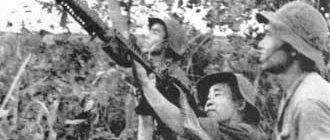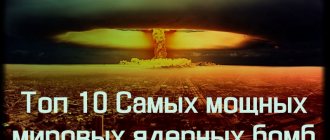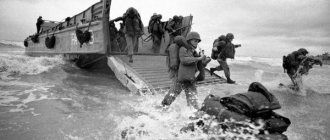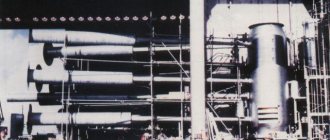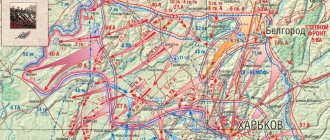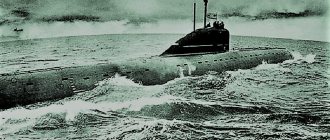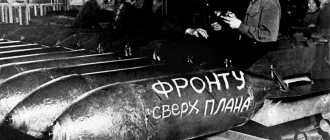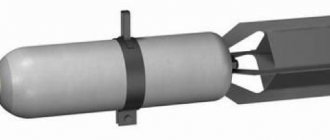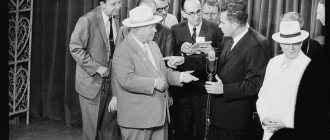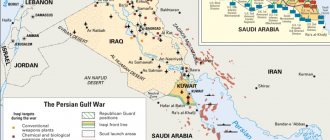In 1965, during the so-called Vietnam War, due to intense bombing by American aircraft, the leadership of the Democratic Republic of Vietnam (DRV) turned to the USSR for help. In the DRV, a Group of Soviet Military Specialists (GMS) was created, at first only from military personnel of the air defense forces, then pilots, sailors, tank crews, and doctors joined it. At different times, the senior officers of the SAF group were: 04.65-09.65 - Major General Dzyza A.M., 09.65-10.67 - Major General Belov G.A., 10.67-12.68 - Colonel General of Aviation V.N. Abramov, 12.68- 12.70 - Lieutenant General of Artillery Stolnikov B.A., 12.70-12.72 - Major General Maksimenko N.K., 12.72-01.75 - Colonel General Hyupenen A.I.
The first rocket launched from this place in 1965. The trench next to the position has been restored.
The origins of Vietnam's air defense
US aircraft began bombing the territory of the Democratic Republic of Vietnam in 1964 after small Vietnamese warships allegedly attacked an American aircraft carrier in the Gulf of Tonkin. It is currently believed that the Tonkin Incident was only a pretext to begin bombing in order to destroy training and supply facilities for South Vietnamese guerrillas in the North. At the beginning of the bombing, the Vietnamese could shoot down American planes with anti-aircraft artillery only at low altitudes. The first plane was shot down on August 5, 1964.
After negotiations with the government of the DRV and transportation of equipment to Vietnam through the PRC in July 1965, the 63rd (commander B.I. Mozhaev) and 64th (commander F.P. Ilinykh) divisions of the 236th air defense missile defense system of the Vietnamese people's army. Beginning in 1965, Soviet air defense equipment entered Vietnam in three ways: through China, by sea on merchant ships, and by transport aircraft by air. The channel through China did not operate for long. Soviet military experts trained Vietnamese missilemen in regimental training centers and at combat positions using the “do as I do” principle, and also taught at Vietnamese higher military educational institutions. After a short period of training, Vietnamese military personnel acquired sufficient skills and the role of Soviet specialists began to consist of consulting on the ground of combat operations and training in new technologies that appeared after continuous improvements carried out in the USSR in institutes and design bureaus.
Number one: napalm
Many people remember him from the film “Apocalypse Now” and the monologue of Lieutenant Colonel Kilgore with the words: “I love the smell of napalm in the morning.”
Napalm is an incendiary mixture consisting of gasoline or diesel fuel and various thickeners. In addition to being flammable (the substance gives a temperature of 800-1200 °C), napalm acquires the property of sticking to all surfaces and maintaining a fire for a long time. This substance was developed against Japanese cities back in World War II, but its peak use occurred in Vietnam.
Between 1963 and 1973, approximately 388,000 tons of napalm bombs were dropped in the region. Although at first they were not bombs: napalm was used in cigar-shaped, non-feathered containers that tumbled when they fell.
Photo: Commons.wikimedia.org
First battle using rockets
On July 24, 1965, the 63rd and 64th Divisions took position for the first time. At approximately 2 p.m., two large targets were detected on the radar screens. These were four Phantoms, traveling in pairs. At 14.25 senior lieutenant V.M. Konstantinov pressed the “Start” button for two channels. The first missile shot down the plane, the second hit it, which was already falling. The second division shot down two more Phantoms here. By decree of Ho Chi Minh, this day began to be celebrated as the Day of the VNA Anti-Aircraft Missile Forces.
American aircraft carriers easily approached the coast of Vietnam, which stretches in a narrow strip along the South China Sea. On the locator screens of the Vietnamese air defense systems, it was clearly visible how planes began to separate from the aircraft carriers and head towards North Vietnam.
Vietnamese military pilots. Photo from the book Ho Chu tich Voi Bo Doi Phong Khong Khong Quan
Links[edit]
- Endicott, Judy G. (1999) Active duty Air Force wings as of 1 October 1995; Active duty United States Air Force flight, space and missile squadrons as of October 1, 1995. Maxwell Air Force Base, Alabama: Air Force History Office. CD-ROM.
- Glasser, Jeffrey D. (1998). The Secret War in Vietnam: US Air Force in Thailand, 1961–1975. McFarland & Company. ISBN 0-7864-0084-6.
- Ravenstein, Charles A. (1984). Pedigree and history of achievements of Air Force combat wings 1947–1977. Maxwell Database, Alabama: Air Force History Office. ISBN 0-912799-12-9.
- Schleit, John (1988), The Offensive Years, 1965–1968, Office of Air Force History, United States Air Force
- Schleit, John (1996), A War Too Long: The History of the United States Air Force in Southeast Asia, 1961–1975, Office of Air Force History, United States Air Force,
- Futrell, Robert F. with assistance from Blumenson, Martin (1991), United States Air Forces in Southeast Asia: The Advisory Years to 1965, Office of Air Force History, United States Air Force
- Van Staveren, Jacob (2002), Gradual Failure: The Air War over North Vietnam, 1965–1966, Office of Air Force History, United States Air Force
Technical and tactical confrontation
After the first losses suffered from the air defense system, the Americans took countermeasures. They began to use Shrike anti-missile systems, active jammers, and unmanned aerial vehicles for reconnaissance at high altitudes. In aviation strike groups, US Air Force aircraft increased the intervals and depth between them, and began to fly at low and extremely low altitudes. “Dead zones” in the valleys between the mountains were skillfully used. They began to use ball bombs, which also killed civilians. For example, according to the recollections of the commander of the 41st Air Defense Division Bondarenko I.V., on June 30, 1967, in the mountainous region of Tamao, VNA air defense crews shot down one F-105 aircraft. After this, the position was subjected to a powerful bomb attack by American aircraft. Several containers of ball bombs were dropped, some of which hit houses in a nearby village, including a kindergarten. Many children and adults died. The Shrike homing missile was launched from American aircraft to destroy anti-aircraft missile systems. It followed the radar beam of the Dvina air defense system and when hit, many balls flew out of it, hitting military personnel and equipment. The entire cabin was riddled with bullets. To combat the Shrikes, the following method was used: when it was detected and the radiation of the radar antenna was turned on, it was moved to the side or up, and then the radiation was turned off. The Shrike, following the maximum radiation, went to the side or upward, and after it was turned off, it lost its homing signal and fell to the side. Soviet military specialists and scientists, and the defense industry, took measures to increase the effectiveness of the use of air defense systems in the new emerging conditions, which brought results. At the battle site, organizational measures and military stratagems were also used. For example, the Vietnamese made mock-up missiles from bamboo, and so skillfully that American pilots often bombed them and reported to their command as for the real result.
Thunder over Sombang
The Sombang Ammunition Depot had 49 buildings on an area of 35 acres. According to American data, the storage capacity was 5 percent of the total capacity of ammunition storage facilities in the Democratic Republic of Vietnam. The air defense suppression group of F-100 and F-105 aircraft was led by the commander of the 67th Tactical Fighter Squadron, Lieutenant Colonel Robinson “Robbie” Risner (Korean War ace, 8 aerial victories). The F-105 strike force was led by 67 Squadron's assistant operations officer, Major James Matthews, and accompanied by Canberras from South Vietnam. The pilots were not ready to actively counter air defense. “We were instructed not to expect any significant anti-aircraft fire in the target area, a phrase I will never forget,” recalled Captain Robert Baird.
Two hours before takeoff. Thunderchief pilots waiting, Korat, March 2, 1965
The suppression team was the first to appear above the target. Having descended to a height of 30 meters, the aircraft began to attack enemy firing points with cannon fire, free-fall bombs and CBU-2/A cluster munitions. Their use required approaching the target at low altitude and in a straight line, which made the aircraft easy targets. The first victim of this tactic was the Super Saber of 1st Lt. Hayden Lockhart from 613 Squadron (serial number 55-2857), hit by 37-mm gun fire - the pilot ejected at an extremely low altitude and managed to stay under the canopy of the parachute for only two or three seconds. Next in line was Captain Baird, flying as Risner's wingman on Thunderchief 61-0214. His testimony:
...as I looked ahead to determine which trees were taller than me, I saw what appeared to be black, greasy smoke spiraling out from the trees directly in front of me.
After the split second it took to think, “What the hell is this?”, I already knew what “it” was. Another split second later, “it” turned into 23mm anti-aircraft guns and banged on my F-105. In a very calm voice, I told the world that I had been hit and was moving away from the target.
While assessing, also calmly, the extent of the damage to my Thad, I noticed holes one to two feet in diameter in the left wing console. I didn't check the right console because now there was smoke in the cockpit. <…> The engine began to surge. I was quickly losing speed. The fire indicator never came on.
I don't remember whether I reported my ejection or just carried it out.
While the battle between suppression aircraft and anti-aircraft guns raged, a strike force of approximately 24 Thunderchiefs and 20 Canberras successfully bombed the warehouse without suffering any casualties. The F-105s on this raid carried a typical load of eight 340 kg M117 bombs. For the B-57, the standard load of the period was nine old 227 kg M64s in the bomb bay and another four of the same or M117s under the wing. In total, about 120 tons of bombs were dropped on the target.
Calculation of the 37-mm anti-aircraft gun 61-K. According to North Vietnamese data, in December 1965, these people shot down 14 American aircraft in four days
In addition to the two planes shot down over Sombang, two more F-105s from the air defense suppression group did not return to base, trying to limp to Korat with battle damage. Aircraft 62-4260, Major George Panas, crashed in Laos, and Aircraft 62-4325, Captain Kenneth Spagnola, crashed in Thailand; both pilots ejected. All three Thunderchiefs lost in the raid were from 67 Squadron.
Vietnamese military aviation
The fire zones of anti-aircraft missile forces and anti-aircraft artillery were still local in nature and were “tied” to certain objects. Therefore, they were supplemented by fighter aircraft. The use of fighter aircraft expanded the combat zone over the entire territory of North Vietnam. The first American aircraft was shot down by Vietnamese pilots in April 1965. Until 1966, MiG-17s were in service with the VNA Air Force. Since February 1966, the main opponents of the American F-4 have been the supersonic MiG-21F-13 and MiG-21PF-V, equipped with missile weapons or units with 55-mm unguided aircraft missiles. The North Vietnamese fighter force consisted of four regiments. The fighters in service were MiG-21, MiG-19 (Chinese production) and MiG-17 remained. Vietnamese pilots quickly mastered the control of MiG-17 and MiG-21 fighters and air combat tactics. The ratio of losses in air battles using only aircraft was 1:2.5 in the initial period of the war and 1:1.8 at the end in favor of the Vietnamese. Vietnamese pilots carried out air battles very skillfully, confusing the Americans, who were accustomed to instructions. Gradually, the Americans gained experience in air combat, which allowed them to reduce their loss ratio.
The only pilot in the world who managed to shoot down a B-52 in an air battle is Pham Thuan. He subsequently became an astronaut and then an air general in Vietnam.
Number five: "Daisy Cutter"
If the Walleye could be called a “smart bomb,” then the BLU-82 “Daisy Cutter” was certainly a stupid bomb in every way. But very powerful - 6.8 tons of conventional explosives. There were no worthy man-made objects for such a bomb in all of Vietnam, and it was not intended to destroy cities. The BLU-82 bomb was used to bomb the jungle if it was necessary to urgently clear a landing area for helicopters. One bomb felled a forest in a circle with a diameter of 100 to 300 meters. The US Air Force did not have bombers capable of delivering a superbomb to its target; it had to be dropped from a C-130 transport aircraft.
A total of 225 BLU-82 units were built.
After Vietnam, the bomb was used during the Gulf War and Afghanistan. The Daisy Cutter was removed from service only in 2008. Photo: Commons.wikimedia.org
